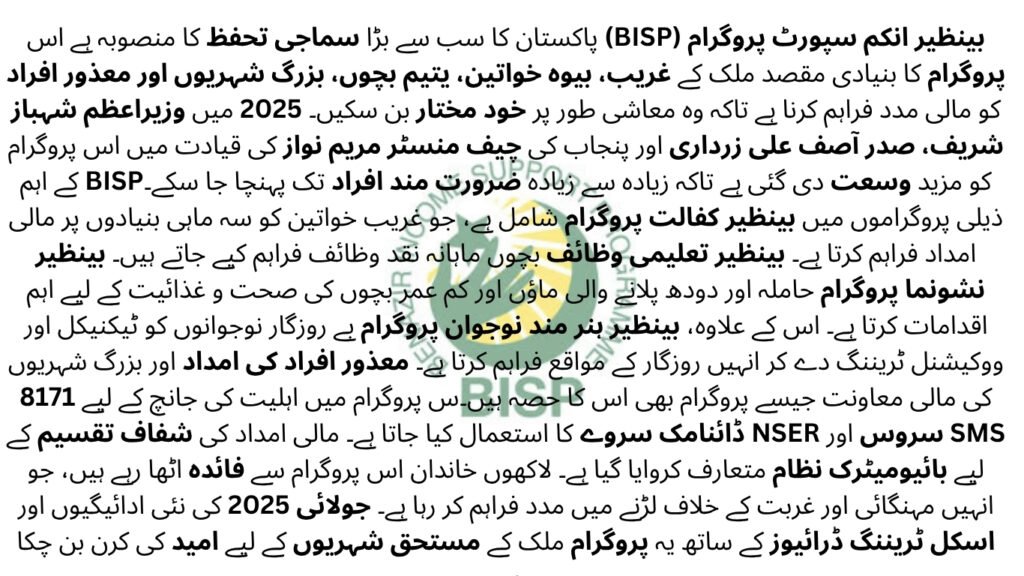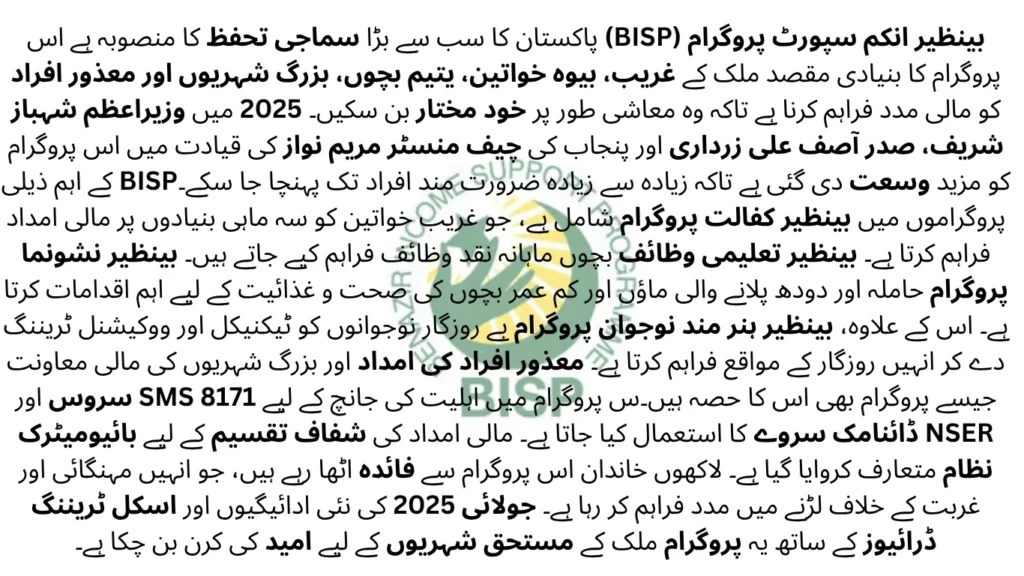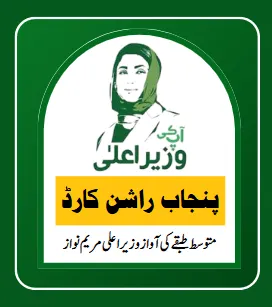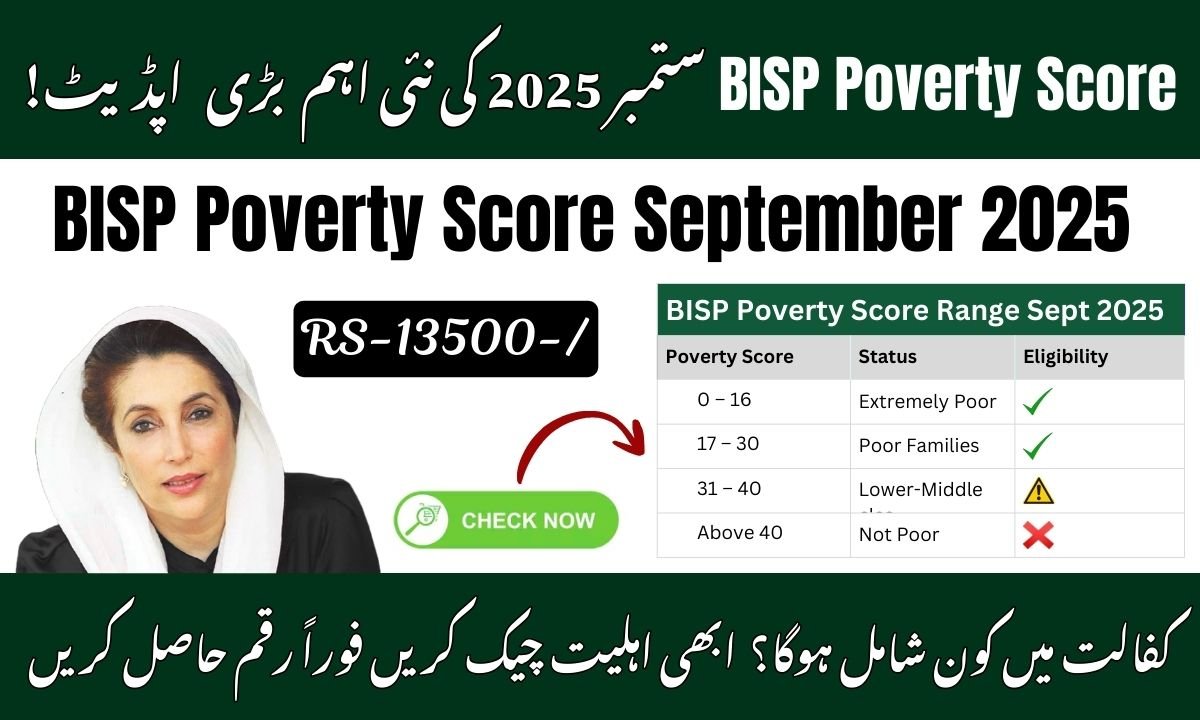The BISP Poverty Score September 2025 is the most important update for families waiting to know if they qualify for aid under the Benazir Income Support Programme. This poverty score is used to decide who deserves financial help and who may not qualify. By checking your poverty score through the NSER (National Socio-Economic Registry) survey or the 8171 Dynamic Survey, women from poor families can instantly know their eligibility status. This system ensures that only the most deserving households receive support for education, food, and healthcare.
For millions of women in Pakistan, the BISP poverty score is not just a number. It is the key to receiving regular cash assistance that can significantly improve daily life. Families struggling with inflation, rising food prices, and high school expenses can finally breathe a sigh of relief with this program. The score is based on household income, living conditions, family size, and whether there is any other source of income. If your poverty score is within the eligible range, you will be added to the BISP Kafaalat program and start receiving quarterly payments.
The BISP Poverty Score September 2025 expansion is part of the government’s plan to widen the social safety net. By raising the coverage to more low-income women, the program helps families in both cities and villages. This is not only financial aid, it is empowerment, relief, and a chance for stability. With simple steps like sending your CNIC to 8171 or checking online, you can quickly find out if you qualify for aid.

Key Highlights of BISP Poverty Score September 2025
| Point | Details |
| Update Year | September 2025 (latest announcement) |
| Focus Group | Low-income women and female-headed households |
| Poverty Score Range | Families with 0–30 score prioritized for BISP aid |
| Support Type | Quarterly cash assistance under BISP Kafaalat |
| Coverage | Nationwide, all provinces and districts are included |
| Eligibility Check | Through 8171 SMS, 8171.pass.gov.pk portal, or BISP offices |
| Survey Requirement | Must be registered in NSER / 8171 Dynamic Survey |
| Policy Status | Approved in Budget 2025 |
| Additional Benefits | Education stipends (Taleemi Wazaif) for children of beneficiaries |
| Main Goal | Poverty reduction, women’s empowerment, and social equality |
What Is the BISP Poverty Score and Why Does It Matter
In September 2025, the poverty score plays a key role in deciding who will qualify for the BISP Kafaalat program. Families with a low score, usually belonging to the poorest segments of society, are included in the program. Women from these households receive quarterly payments to cover food, education, and healthcare needs.
The reason the poverty score matters so much is that it ensures fairness and transparency. Without this system, many deserving families might be left out, while others who do not truly need help could wrongly benefit. By relying on poverty score data, BISP makes sure that financial aid goes directly to the most vulnerable groups, especially female-headed households and women living in rural or underserved areas.
In simple words, your poverty score decides whether you can get regular cash support under BISP or not. If your score shows that you belong to a low-income family, you qualify for aid. If your score is above the threshold, you may not be eligible. This system protects fairness, prevents misuse, and strengthens the fight against poverty across Pakistan.
How the Poverty Score Is Calculated in the NSER Survey
The NSER (National Socio-Economic Registry) survey is the backbone of the BISP Poverty Score September 2025. It collects information from households across Pakistan to determine who should qualify for financial support. Every family that wants to be part of the BISP Kafaalat Program must complete this survey, as it provides the data needed to calculate the poverty score.
The survey team visits homes and asks simple questions about income, family size, education level, assets, and living conditions. Each answer is given a score. For example, a family with no regular income, children not in school, and poor living arrangements will receive a lower poverty score, which makes them eligible for BISP aid. On the other hand, families with stable income, property, or government salaries will get a higher score, making them ineligible.
The poverty score is not random. It follows a set formula designed by the government to fairly judge economic conditions. Factors that are checked in the NSER survey include:
- Household Income: Whether the family earns below or above the poverty line
- Assets Owned: If the family owns land, vehicles, or property
- Education Level: School attendance of children and adult literacy rate
- Employment Status: Whether any family member has a permanent government or private job
- Family Size: Number of dependents supported by the household
- Living Conditions: Type of house, access to electricity, water, and basic facilities
Once all this information is recorded, the system generates a poverty scorecard. Families with scores below the official threshold set for September 2025 are marked as eligible for BISP Kafaalat payments.
BISP Poverty Score Range September 2025
The BISP Poverty Score September 2025 follows a set range to classify households. Families with lower scores are considered more deserving and qualify for financial aid, while higher scores may mean ineligibility.
| Poverty Score Range | Status | Eligibility |
| 0 – 16 | Extremely Poor | Automatically eligible for BISP aid |
| 17 – 30 | Poor Families | Eligible for BISP Kafaalat (after verification) |
| 31 – 40 | Lower-Middle Income | May qualify under special categories (widows, disabled, etc.) |
| Above 40 | Stable / Not Poor | Not eligible for BISP financial support |
Step-by-Step Guide to Check Your BISP Poverty Score Online
Checking your BISP Poverty Score September 2025 is now very easy. The government has introduced a digital system that allows families to verify their eligibility without confusion. If you have completed the NSER survey or updated your details in the 8171 Dynamic Survey, you can instantly confirm whether you qualify for financial aid under the BISP Kafaalat program.
Here’s a simple step-by-step guide:
Method 1: 8171 Web Portal
- Open your mobile or computer browser and visit the Official Website.
- Enter your 13-digit CNIC number in the required box
- Add the captcha code shown on the screen for verification
- Click the submit button
- The system will display your poverty score result and tell you whether you are eligible or not
Method 2: SMS Service (8171)
- Type your 13-digit CNIC number in a text message
- Send the SMS to 8171
- Within a few minutes, you will receive a reply with your eligibility details
Method 3: BISP Office Visit
- Go to your nearest BISP office or service center
- Provide your CNIC to the representative
- They will check your poverty score and confirm your eligibility on the spot
Tip: Always ensure that your CNIC is valid and updated in NADRA records. Without this, your poverty score may not show correctly on the system.
Common Reasons for Ineligibility in BISP 2025
While the BISP Poverty Score September 2025 is designed to help the poorest families, not everyone qualifies. Many women are marked ineligible because their household does not meet the official criteria. Knowing the common reasons for ineligibility can save time and prevent confusion when applying for BISP Kafaalat aid.
Here are the main reasons families are often declared ineligible:
- High Poverty Score: If your score is above 30, your household may not be considered poor enough to qualify.
- Government Employment: If you or your spouse works in a government job or receives a pension, you are excluded from the program.
- Stable Income Source: Families with steady private jobs, businesses, or property income are usually ineligible.
- Multiple Properties or Assets: Owning land, houses, vehicles, or other valuable assets increases your score and makes you ineligible.
- Invalid or Expired CNIC: Without a valid NADRA CNIC, eligibility cannot be confirmed.
- Survey Not Completed: If your data is missing from the NSER / 8171 Dynamic Survey, you will not appear as eligible.
- Duplicate Applications: Submitting more than one application under different CNICs may also result in rejection.
Important Note: Some families who are not eligible for BISP Kafaalat might still qualify for other assistance programs like Taleemi Wazaif (education stipends) or regional subsidy schemes. By understanding these reasons, families can correct mistakes (such as updating CNIC, completing surveys, or removing duplicate entries) and improve their chances of being included in the next update.
Poverty Score Eligibility Criteria in September 2025
Poverty Score Criteria for Women Beneficiaries
In the September 2025 update, BISP has placed strong focus on women. Since the program mainly supports women, families where the female head falls under the required poverty score range (0–32) can easily qualify for aid. Whether it’s a married woman, a divorced woman, or a woman managing her home on her own, BISP gives her priority. The aim is to empower women by giving them direct financial support so they don’t have to depend on others.
Poverty Score Criteria for Widows and Orphans
Widows and orphans are among the most vulnerable groups in society, and BISP makes sure they are not left behind. Under the new rules, families without an earning male member or children without parental support are given a lower poverty score, which increases their chances of eligibility. Widows looking after their children and orphans attending school are specially prioritized so they can get financial relief and continue their education without worry.
Poverty Score Criteria for Persons with Disabilities
Families that include a person with a disability are also given preference in the poverty score system. Whether it’s a physical or mental disability, such households are recognized as highly vulnerable. To support them, their poverty score is adjusted so they can qualify for financial aid. This step shows BISP’s inclusive vision , making sure that even families struggling with disability-related challenges are supported financially.
Poverty Score and Its Impact on Taleemi Wazaif Enrollment
The poverty score doesn’t just decide financial aid ,it also affects children’s education through Taleemi Wazaif. Families with lower scores automatically qualify for scholarships for their children, covering both school and college levels. This update ensures that poverty is not a barrier to education. If a family’s poverty score falls within the required limit, their children are directly enrolled for Taleemi Wazaif, opening doors for a brighter future.
Benefits of Qualifying Under the BISP Poverty Score 2025
- Quarterly Cash Payments: Extra money to manage household expenses
- Relief from Rising Food Prices: Helps families afford essentials like flour, sugar, and ghee
- Support for Children’s Education: Stipends to keep kids in school
- Better Health Access: Medicine and healthcare for women and children
- Nationwide Coverage: Available in cities, towns, and remote villages
- Women’s Empowerment: Women control the money directly
- Step Out of Poverty: Helps families gradually improve living standards
- Secure Payments: Money goes directly to CNIC-linked accounts or BISP centers
- Support for Female-Headed Households: Helps women manage family expenses independently
- Reduced Child Labor Risk: Financial support prevents children from leaving school to work
- Improved Nutrition: Families can buy healthier food for kids
- Energy & Utility Assistance: Helps cover electricity, gas, and water costs
- Financial Stability: Reduces daily financial stress for low-income households
- Encourages Girls’ Education: Extra support for school-going daughters
- Access to Health Clinics: Funds help pay for basic check-ups
- Community Empowerment: Women with cash influence local economic decisions
- Social Safety Net: Protects families from extreme poverty during crises
- Easy Access to Information: Eligibility can be checked via SMS or a web portal
- Regular Monitoring & Updates: NSER and 8171 surveys keep benefits accurate
- Boosts Confidence & Independence: Women feel more secure and empowered financially
Common Errors While Checking Poverty Score Online
| Error | Reason | Solution |
|---|---|---|
| Wrong CNIC Number | CNIC typed incorrectly | Recheck and enter the correct CNIC digits |
| Expired CNIC | CNIC is no longer valid | Renew your CNIC from NADRA before checking |
| Slow or Busy Portal | Heavy traffic on 8171 web portal | Wait a few minutes and try again later |
| Incomplete Data Records | Missing or outdated household info | Update details through BISP Dynamic Survey |
| Network Issues | Weak internet or mobile connection | Use a stable internet connection for checking |

Conclusion
The BISP Poverty Score September 2025 is a vital tool for identifying families that truly need financial support in Pakistan. By using this score, the government ensures that low-income women and female-headed households receive timely quarterly cash assistance through the BISP Kafaalat program. Checking your poverty score is simple via 8171 SMS, the 8171 portal, or by visiting a BISP office. Families with scores 0–30 are prioritized, while those above 30 may not qualify unless they fall under special categories like widows, disabled women, or exceptionally vulnerable households. This system helps families cover daily expenses, support children’s education, access healthcare, and gain financial independence. Expanding coverage under the 2025 update reflects the government’s commitment to poverty reduction, women’s empowerment, and social equality. If you haven’t checked your BISP Poverty Score September 2025, act now to see if you qualify for this life-changing support.
FAQs – BISP Poverty Score September 2025
Q1: What is the BISP Poverty Score for September 2025?
The poverty score is a number assigned to households through the NSER survey to determine eligibility for BISP Kafaalat financial aid.
Q2: Who qualifies for BISP aid in September 2025?
Women who are heads of low-income households with a poverty score between 0–30, a valid CNIC, and no government job or pension.
Q3: How can I check my BISP Poverty Score?
Check via 8171 SMS, Web Portal, or by visiting a BISP office with your CNIC.
Q4: What is the eligible poverty score range for BISP 2025?
Families scoring 0–30 are prioritized for cash aid, while scores above 30 are generally ineligible unless special criteria apply.
Q5: Can men apply for BISP Kafaalat using the poverty score?
No. Only women are registered as beneficiaries, but men can help their families complete the survey.
Q6: How much aid will eligible women receive in 2025?
Currently, women receive up to Rs. 13,500 per quarter, which may be adjusted with inflation in future policy updates.
Q7: What documents are needed to check eligibility?
A valid and active CNIC registered with NADRA is required to verify your poverty score.
Q8: Can my family still receive education support if the poverty score is above 30?
Yes, children may qualify for Taleemi Wazaif even if the household is not fully eligible for cash aid.
Q9: How often is the poverty score updated?
It is updated regularly through the 8171 Dynamic Survey and NSER records to reflect accurate household conditions.
Q10: Why is the BISP Poverty Score important?
It ensures financial aid reaches genuinely needy families, reduces misuse of funds, and helps women manage household expenses, education, and healthcare effectively.

